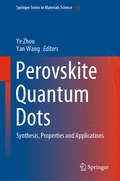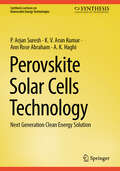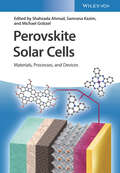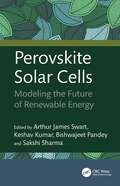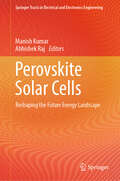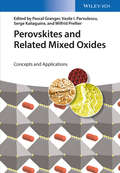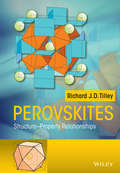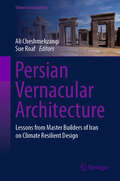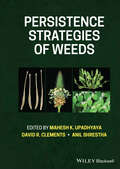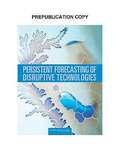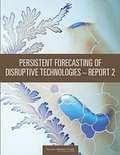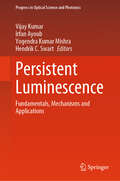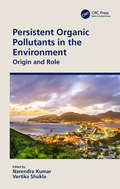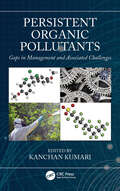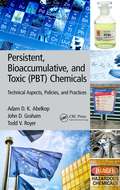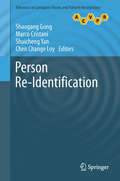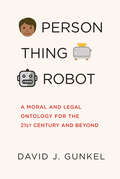- Table View
- List View
Perovskite Quantum Dots: Synthesis, Properties and Applications (Springer Series in Materials Science #303)
by Yan Wang Ye ZhouThis book addresses perovskite quantum dots, discussing their unique properties, synthesis, and applications in nanoscale optoelectronic and photonic devices, as well as the challenges and possible solutions in the context of device design and the prospects for commercial applications. It particularly focuses on the luminescent properties, which differ from those of the corresponding quantum dots materials, such as multicolor emission, fluorescence narrowing, and tunable and switchable emissions from doped nanostructures. The book first describes the characterization and fabrication of perovskite quantum dots. It also provides detailed methods for analyzing the electrical and optical properties, and demonstrates promising applications of perovskite quantum dots. Furthermore, it presents a series of optoelectronic and photonic devices based on functional perovskite quantum dots, and explains the incorporation of perovskite quantum dots in semiconductor devices and their effect of the performance. It also explores the challenges related to optoelectronic devices, as well as possible strategies to promote their commercialization. As such, this book is a valuable resource for graduate students and researchers in the field of solid-state materials and electronics wanting to gain a better understanding of the characteristics of quantum dots, and the fundamental optoelectronic properties and operation mechanisms of the latest perovskite quantum dot-based devices.
Perovskite Solar Cells Technology: Next Generation Clean Energy Solution (Synthesis Lectures on Renewable Energy Technologies)
by A. K. Haghi Ann Rose Abraham K. V. Kumar P. Arjun SureshSolar energy is considered one of the most important forms of renewable energy. Silicon solar cells are commonly used in the photovoltaic industry, but their higher production costs and complicated fabrication processes make them less affordable. Various other technologies, such as perovskite solar cells and dye-sensitized solar cells, are also emerging. Among these, perovskite solar cells are promising type of solar cells, offering comparable efficiency to that of silicon solar cells, at significantly lower costs. However, one of the drawbacks of perovskite solar cells is their relatively short lifespan, which limits their applications. Researchers are actively working to improve both the lifetime and efficiency of perovskite solar cells. This book begins by covering the basics of solar energy and the principles and different types of solar cells. The focus is then put on perovskite solar cells, how they work, their advantages and challenges, and what sets them apart from other solar cells. Device fabrication techniques and recent advancements in the field are discusses next, finishing up with a look into the future of solar cell technology.
Perovskite Solar Cells: Fundamental Approaches and Materials Processing for Sustainable Future (Springer Tracts in Electrical and Electronics Engineering)
by Abhishek Srivastava Parasharam M. ShirageThis book excavates into both the foundational principles and the latest advancements in perovskite solar cell research. It presents ground-breaking results about the diverse applications of perovskite solar cells, offering readers a comprehensive overview of the field's current state. By combining fundamental knowledge with cutting-edge methods, this book equips researchers, students, and professionals with valuable insights, fostering innovation and progress in the realm of perovskite solar cell technology. This volume captivates readers with a diverse array of intriguing topics. The book provides valuable insights into tackling challenges and discovering solutions, from the in-depth exploration of various electrical modeling techniques to the revelation of advanced perovskite fabrication methods. Additionally, readers will be engrossed by the exploration of efficiency improvements and the unveiling of novel applications in the realm of renewable energy. This comprehensive coverage ensures that the book appeals to researchers, engineers, and enthusiasts, inspiring them to delve deeper into the world of perovskite solar cells and contribute to sustainable energy solutions. The book also features an array of detailed illustrations and tables, facilitating a comprehensive comparison of different perovskite types. Through a didactic approach, complex concepts are presented in a reader-friendly manner, enabling researchers and enthusiasts alike to grasp cutting-edge methods, results, and applications in the field of perovskite solar cells. This book serves as a valuable resource, empowering readers to contribute to the advancement of clean energy solutions with a deeper understanding of next-generation technologies. This book offers readers a transformative opportunity to develop a comprehensive understanding of perovskite solar cells. Through its insightful exploration of fundamental principles, cutting-edge methods, and ground-breaking applications, the book equips readers with the knowledge and expertise needed to actively participate in developing next-generation clean energy solutions. This invaluable resource empowers researchers, engineers, and students to embrace the potential of perovskite solar cells, driving innovation and progress in the pursuit of a sustainable and environmentally friendly future.
Perovskite Solar Cells: Materials, Processes, and Devices
by Shahzada AhmadPresents a thorough overview of perovskite research, written by leaders in the field of photovoltaics The use of perovskite-structured materials to produce high-efficiency solar cells is a subject of growing interest for academic researchers and industry professionals alike. Due to their excellent light absorption, longevity, and charge-carrier properties, perovskite solar cells show great promise as a low-cost, industry-scalable alternative to conventional photovoltaic cells. Perovskite Solar Cells: Materials, Processes, and Devices provides an up-to-date overview of the current state of perovskite solar cell research. Addressing the key areas in the rapidly growing field, this comprehensive volume covers novel materials, advanced theory, modelling and simulation, device physics, new processes, and the critical issue of solar cell stability. Contributions by an international panel of researchers highlight both the opportunities and challenges related to perovskite solar cells while offering detailed insights on topics such as the photon recycling processes, interfacial properties, and charge transfer principles of perovskite-based devices. Examines new compositions, hole and electron transport materials, lead-free materials, and 2D and 3D materials Covers interface modelling techniques, methods for modelling in two and three dimensions, and developments beyond Shockley-Queisser Theory Discusses new fabrication processes such as slot-die coating, roll processing, and vacuum sublimation Describes the device physics of perovskite solar cells, including recombination kinetics and optical absorption Explores innovative approaches to increase the light conversion efficiency of photovoltaic cells Perovskite Solar Cells: Materials, Processes, and Devices is essential reading for all those in the photovoltaic community, including materials scientists, surface physicists, surface chemists, solid state physicists, solid state chemists, and electrical engineers.
Perovskite Solar Cells: Modeling the Future of Renewable Energy
by Bishwajeet Pandey Keshav Kumar Arthur James Swart Sakshi SharmaThis book provides a comprehensive overview of the role of modeling in advancing perovskite solar cell technology and its implications for the future of renewable energy. It encompasses various aspects of perovskite solar cell modeling, including computational modeling and simulation techniques, experimental validation methods, optimization strategies, and performance evaluation metrics.Features:• Discusses the basic principles, working mechanisms, materials, and designing approaches related to the implementation of perovskite solar cells.• Covers electron and hole transport models, computational approaches to charge transport, and transport in different perovskite structures.• Illustrates the crystal structure, composition, optical and electronic properties, stability, and degradation mechanisms of perovskite materials.• Explains tandem solar cell design principles, interface engineering for tandems, and stability challenges in tandem solar cells.• Explores the performance parameters related to perovskite solar cells and the implementation of such devices.It is primarily written for senior undergraduates, graduate students, and academic researchers in electrical engineering, electrical and communications engineering, energy engineering, renewable energy, and computer science and engineering.
Perovskite Solar Cells: Reshaping the Future Energy Landscape (Springer Tracts in Electrical and Electronics Engineering)
by Manish Kumar Abhishek RajPerovskite Solar Cells (PSCs) have shown the significant advancement in the field of photovoltaic technologies, which are transforming the renewable energy landscape through their remarkable efficiency and adaptability. This Book explores the synthesis techniques, characterization, and utilization of perovskite materials, including lead-free alternatives, tandem configurations, and novel strategies for indoor and large area PSCs. Featuring detailed analyses of the fundamental optoelectronic properties, stability issues, and device engineering techniques, this volume offers critical insights into the scientific advancements driving innovations in sustainable and high-performance solar energy solutions. This book serves as vital resource for researchers, materials scientists, and industry professionals interested in the groundbreaking potential of perovskite solar cells in redefining the future of photovoltaics.
Perovskites and Related Mixed Oxides
by Vasile I. Parvulescu Pascal Granger Wilfrid Prellier Serge KaliaguineThis comprehensive handbook and ready reference details all the main achievements in the field of perovskite-based and related mixed-oxide materials. The authors discuss, in an unbiased manner, the potentials as well as the challenges related to their use, thus offering new perspectives for research and development on both an academic and industrial level. The first volume begins by summarizing the different synthesis routes from molten salts at high temperatures to colloidal crystal template methods, before going on to focus on the physical properties of the resulting materials and their related applications in the fields of electronics, energy harvesting, and storage as well as electromechanics and superconductivity. The second volume is dedicated to the catalytic applications of perovskites and related mixed oxides, including, but not limited to total oxidation of hydrocarbons, dry reforming of methane and denitrogenation. The concluding section deals with the development of chemical reactors and novel perovskite-based applications, such as fuel cells and high-performance ceramic membranes. Throughout, the contributions clearly point out the intimate links between structure, properties and applications of these materials, making this an invaluable tool for materials scientists and for catalytic and physical chemists.
Perovskites: Structure-Property Relationships
by Richard J. TilleyUniquely describes both the crystallography and properties of perovskite related materials. Practical applications in solar cells, microelectronics and telecommunications Interdisciplinary topic drawing on materials science, chemistry, physics, and geology Contains problems and answers to enhance knowledge retention
Perseverance and the Mars 2020 Mission: Follow the Science to Jezero Crater (Springer Praxis Books)
by Manfred "Dutch" von EhrenfriedThis is the comprehensive story of NASA’s pioneering Mars 2020 mission, which at this moment continues to break ground on the surface of the Red Planet.The book takes readers through every stage of the Mars mission, describing its major goals and objectives, the cutting-edge technology and instrumentation onboard the Perseverance rover and other spacecraft components, and the members of the scientific team who steered the mission along the way. Mars 2020 is the first to actually take samples of the Red Planet and prepare them for subsequent return to Earth. The chapters therefore delve into how and why Jezero Crater was selected as the optimal landing and sample collecting site to meet the mission objectives. Featuring dozens of high-resolution images of the mission, this book gives readers a deeper understanding of the technology underlying Mars 2020 and why its work is so important for planetary science and space exploration.
Persian Vernacular Architecture: Lessons from Master Builders of Iran on Climate Resilient Design (Urban Sustainability)
by Ali Cheshmehzangi Sue RoafThis timely book aims to address a significant challenge in contemporary design and architecture, i.e., “to learn from the vernacular”. Vernacular architecture refers to traditional and indigenous building styles that have evolved in response to local climate, materials, and cultural practices. These styles often embody 'extreme' design principles, as they support life without relying on modern mechanical systems for heating and cooling. The core premise of the book is that these time-tested design solutions offer valuable lessons for real sustainable and climate-resilient architecture today. We strongly urge a return to the vernacular as a source of inspiration and knowledge. Hence, a genuine dedication to dedicated Ostads or master builders of Iran, who have contributed extensively to making and co-creating climate-resilient architecture and climate-sensitive design. This is more than just a box-ticking sustainability exercise and delves more deeply into the building performance and its impact on our everyday life, our health and wellbeing, and us as human beings. The book posits that contemporary architects and designers can learn valuable lessons by studying the adaptive strategies and sustainable practices embedded in the traditional vernacular architecture of Iran. These lessons are crucial for addressing modern challenges such as climate change, resource scarcity, and the need for energy-efficient buildings. By revisiting and analysing vernacular architecture, the book aims to bridge the gap between traditional knowledge and contemporary design practices. It provides a comprehensive exploration of how vernacular principles can be integrated into modern architectural education and practice. The goal is not only to preserve traditional wisdom but also to innovate upon it, creating buildings that are both culturally relevant and environmentally sustainable. The contributing case study chapters of the book include an excellent range of practical recommendations for architects, researchers, and policymakers. By fostering a deeper understanding of vernacular architecture, the book seeks to inspire a new generation of architects to create buildings that are harmonious with their environment and resilient to future challenges. Through this approach, we believe lessons from vernacular buildings ought to offer the promise of reintegrating real Resilience into the design of the next generation of buildings.
Persistence Strategies of Weeds
by Mahesh K. Upadhyaya David R. Clements Anil ShresthaAn invaluable source of up-to-date information on all major aspects of weed persistence Weeds negatively impact crop yields, the quality of agricultural produce, the health of livestock and ecosystems, and various aspects of human life. Despite significant expenditures of time, money, and resources by agricultural producers, land managers, and the general public, weeds persist. Developing new methods for protecting crops and the environment requires a thorough understanding of the persistence mechanisms of weeds. In Persistence Strategies of Weeds, an international team of expert authors provide detailed information on weed seed biology, identify the vulnerabilities of different weeds, and address the underlying issues behind the problem of weed persistence despite various management methods including herbicides. Presenting a comprehensive approach to the subject, the authors describe what is already understood about weed persistence and what yet needs to be determined. Topics include the role of seed production, dissemination, seed banks, the physiology and genetics of seed dormancy, the influence of agronomic practices, seed longevity, vegetative propagation, allelopathy, predation, soil microbes, weed evolution, and more. This authoritative volume: Examines the genetic flexibility of weeds to adapt to changes in agricultural practices and management strategies Discusses the release of allelochemicals by certain weeds that inhibit the growth of competing plant species Explores the influence of climate change on weed persistence and how the efficacy of herbicides will be affected Emphasizes the importance of sustainable crop production and reducing dependence on synthetic herbicides Provides extensive coverage of the roles of genetic, environmental, and morphological factors in the regulation of weed seed dormancy Includes an overview of persistence strategies of weeds, detailed case studies, and numerous illustrative examples Persistence Strategies of Weeds is an ideal textbook for all upper-level undergraduate and graduate students of weed and pest biology, agroecology, or organic agriculture, and a must-have reference for weed scientists and weed management professionals.
Persistent Forecasting of Disruptive Technologies
by National Research Council of the National AcademiesTechnological innovations are key causal agents of surprise and disruption. In the recent past, the United States military has encountered unexpected challenges in the battlefield due in part to the adversary's incorporation of technologies not traditionally associated with weaponry. Recognizing the need to broaden the scope of current technology forecasting efforts, the Office of the Director, Defense Research and Engineering (DDR&E) and the Defense Intelligence Agency (DIA) tasked the Committee for Forecasting Future Disruptive Technologies with providing guidance and insight on how to build a persistent forecasting system to predict, analyze, and reduce the impact of the most dramatically disruptive technologies. The first of two reports, this volume analyzes existing forecasting methods and processes. It then outlines the necessary characteristics of a comprehensive forecasting system that integrates data from diverse sources to identify potentially game-changing technological innovations and facilitates informed decision making by policymakers. The committee's goal was to help the reader understand current forecasting methodologies, the nature of disruptive technologies and the characteristics of a persistent forecasting system for disruptive technology. Persistent Forecasting of Disruptive Technologies is a useful text for the Department of Defense, Homeland Security, the Intelligence community and other defense agencies across the nation.
Persistent Forecasting of Disruptive Technologies - Report 2
by National Research Council of the National AcademiesThe term "disruptive technology" describes a technology that results in a sudden change affecting already established technologies or markets. Disruptive technologies cause one or more discontinuities in the normal evolutionary life cycle of technology. This may lead to an unexpected destabilization of an older technology order and an opportunity for new competitors to displace incumbents. Frequently cited examples include digital photography and desktop publishing. The first report of the series, Persistent Forecasting of Disruptive Technologies, discussed how technology forecasts were historically made, assessed various existing forecasting systems, and identified desirable attributes of a next-generation persistent long-term forecasting system for disruptive technologies. This second book attempts to sketch out high-level forecasting system designs. In addition, the book provides further evaluation of the system attributes defined in the first report, and evidence of the feasibility of creating a system with those attributes. Together, the reports are intended to help the Department of Defense and the intelligence community identify and develop a forecasting system that will assist in detecting and tracking global technology trends, producing persistent long-term forecasts of disruptive technologies, and characterizing their potential impact on future U.S. warfighting and homeland defense capabilities.
Persistent Luminescence: Fundamentals, Mechanisms and Applications (Progress in Optical Science and Photonics #30)
by Vijay Kumar Hendrik C. Swart Yogendra Kumar Mishra Irfan AyoubThis book presents the fundamental and applied properties of different phosphor materials that exhibit the phenomenon of persistent luminescence (PerLum). PerLum offers a solution for the limitations of existing fluorescent probes, with new lanthanide-based materials for in vivo bio-imaging and demonstrates the practical applications of these materials. The book offers a basic understanding of PerLum, different mechanisms, models, related spectroscopic techniques, and a few applications essential for anyone interested in learning about PerLum materials. This is partly due to the fact that the property of long-lasting luminescence is closely associated with other properties and functionalities, which besides being essential for many technological applications, such as bioimaging and biosensing, involve in-depth physics and chemistry. Although the concept of luminescence has been explored for many decades, the different types of luminescence have always led to versatile breakthroughs in different fields of science and technology. Among the same is one more well-established phenomenon known as "PerLum," which is characterized by the maintenance of luminescence for periods ranging from minutes to hours in the absence of an external excitation source. Because of their remarkable properties, an enormous number of PerLum materials have been developed and are now widely used in a variety of fields, particularly bioimaging, biosensing, therapeutics, etc.
Persistent Organic Pollutants in Aquatic Systems: Classification, Toxicity, Remediation and Future (Emerging Contaminants and Associated Treatment Technologies)
by Gehan Mohamed El Zokm Tarek Othman SaidThis book addressed an in-depth comprehension of the classifications and characterizations of POPs, which have become global issues due to bioaccumulation, persistency, and toxicity. It represents the milestones of the development of pesticide application, industry, and management. Banned SC-POPs have special investigations. It discusses air-sea exchange, ocean currents, phase distribution, speciation, adsorption, desorption, and degradation as the key processes that control POP's fate. The book explores several aspects of POP chemistry that have a direct influence on their biochemical and toxicological consequences. The book illustrates the dynamic equilibriums influencing the proportion of a POP's gaseous, liquid, and solid phases. The book discussed POP migration by referring to the grasshopper effect. It also explores the impacts of climate change on emissions and the fate of POPs through a global-scale multimedia fate model. Additionally, it displays the impact of potential global change scenarios on POP bioaccumulation patterns. The book is directed at giving a deep discussion of the method's QA/QC process for POP determination and has verified the accuracy and precision of the procedures. As a distinctive point, it discusses many aspects concerning the toxicity of POPs. It reports mechanisms describing the toxicity of POPs on immune systems, carcinogenesis, endocrine, neural, and reproductive systems. The book keeps an eye on a model describing the global distribution and toxicity of PAHs. Among the exclusive points in the book is the evaluation of the recent ecological status in Egypt relative to POPs through a time-scale overview and recent case studies. It provides thematic literature related to DDC research in Africa through the WoS and Scopus databases from 1949 to 2021. The book emphasizes models for predicting the annual contribution rate of POPs as a way to raise public awareness about POPs. The greatest challenge for the book is how to motivate the audience to be aware of these hazardous materials in marine ecosystems. Moreover, this book will be of great interest to academics, professionals, practitioners, post-graduate students, and undergraduates because it gives a clear overview of POPs in the marine environment. It also provides decision-makers with a realistic perspective of the environmental file, allowing them to address environmental issues and directing stockholders to safer locations for environmental activity. From a future perspective, the regulation of pervasive POPs, with special reference to recently evaluated harmful substances (PFASs), has faced significant challenges in the wake of pressure from regulators.
Persistent Organic Pollutants in the Environment: Origin and Role
by Narendra KumarPersistent Organic Pollutants (POPs) are toxic, degradation resistant, bio accumulative, and display wide spatial distribution which has been linked to mutagenic, reproductive and immunological disorders. In Stockholm Persistent Organic Pollutants (POPs) are toxic, degradation resistant, bio-accumulative, and display wide spatial distribution, which has been linked to mutagenic, reproductive, and immunological disorders. At the Stockholm Convention, a global treaty was signed to minimize and ultimately eliminate the release of POPs into the environment. The present compilation regarding POPs focusses on the sources, atmospheric behavior, terrestrial and aquatic food chain transfer, human exposure, and fate aspects of this important class of chemicals, including topical issues like temporal trends in contamination. Furthermore, the chemical characteristics of individual POPs are also addressed. Features: Provides better understanding of Persistent Organic Pollutants (POPs) and how they affect humans and ecosystems. Includes genesis, categories, environmental fate and behavior, and associated hazards. Reviews analytical techniques involved in detection, human exposure and management. Discusses environmental dynamics of POPs. Focuses on the comprehensive account of PCDD/Fs, PCBs, PAH and other organochlorine POPs, such as DDT, lindane, and dieldrin. This book is aimed at researchers, professionals and graduate students in Life Science, Occupational Health and Safety, Chemical Engineering and Environmental Engineering.
Persistent Organic Pollutants: Gaps in Management and Associated Challenges
by Kanchan KumariPersistent Organic Pollutants (POPs) are chemicals that resist environmental degradation and cause deleterious effects on the environment and human wellbeing. Once released into the environment they can travel long distances and persist for longer duration. This book highlights the complex area of POPs in simple language and deals with the fundamentals of the chemicals, their sources, and impacts on human health. The book also unfolds several other aspects like new and advanced analytical detection methods, gaps in management, effectiveness of the Stockholm convention, and the role of the global monitoring plan on POPs for crucial and holistic understanding about POPs. It also investigates how to minimize the impact of POPs and the major gaps and challenges in sound management of POPs. With its comprehensive approach, this book is an indispensable source of knowledge for those studying and working to mitigate the effect of POPs in the environment.
Persistent Progressives: The Rocky Mountain Farmers Union
by John F. FreemanPersistent Progressives tells the story of the Rocky Mountain Farmers Union’s evolution from an early movement against monopolists and wholesalers to a regional trailblazer for agriculture ideologies built on social democracy, the family farmer, and cooperative enterprises. As a continuing advocate for saving the family farm, the Farmers Union legacy provides a unique window into the transformation of the agriculture and rural communities in Wyoming, Colorado, and New Mexico. Using data spanning decades, author John Freeman covers the founding of the RMFU in 1907 until the present, demonstrating how members continually sought to control the means of production and marketing by forming cooperatives, providing consumer services, and engaging in politics. Powering this evolution was a group of “practical idealists”—the Farmers Union leaders and titular persistent progressives who shaped the organization’s growth and expansion. Initiated by Jim Patton, who brought the organization out of its oppositional roots and into its cooperative advocacy, the RMFU passed to John Stencel and then David Carter, joining hands with agricultural conservationists and small organic producers along the way to carry the torch for progressive agrarianism in today’s urbanized world. Shaken but undeterred by some notable failures, its leadership remains convinced of the efficacy of cooperatives as a means to achieve justice for all. Discussing the broader social, economic, political, and environmental issues related to farming, ranching, and urbanization, Persistent Progressives seamlessly blends regional history with ongoing issues of agricultural and economic development.
Persistent Work-related Technology Use, Recovery and Well-being Processes
by Lenka Ďuranová Sandra OhlyTheaim of this work is to provide insight into the process of employee recoveryand well-being in regard to work-related ICT use during after-hours. Therefore,we discuss (1) theories that help us to understand the determinants andoutcomes of this behavior, (2) our core concepts recovery and well-being, and(3) previous empirical findings on ICT use after hours for work purposes. Onthe basis of literature review, we propose a new conceptual overall frameworkof ICT use after hours for work purposes with the focus on employee recoveryand well-being processes. Thereby, we posit ICT use after hours for workpurposes as potential stressor, resource, or demand (see action theory byHacker, 1998, 2003; Frese and Zapf 1994), depending on many personal and environmentalfactors, but primarily on cognitive appraisals (see transactional model ofstress by Lazarus and Folkman 1984). This three-way division enables us topropose various linear and non-linear associations to focused outcomes. Weconclude with an overall discussion on further research concerning theidentified research gaps.
Persistent, Bioaccumulative, and Toxic (PBT) Chemicals: Technical Aspects, Policies, and Practices
by John D. Graham Adam D. Abelkop Todd V. RoyerDeveloped from the efforts of a multiyear, international project examining how persistent, bioaccumulative, and toxic (PBT) chemicals are evaluated and managed, Persistent, Bioaccumulative, and Toxic (PBT) Chemicals: Technical Aspects, Policies, and Practices focuses on improving the processes that govern PBTs. Incorporating science and policy literature—as well as interviews and panel discussions featuring experts from around the world—this book provides you with an international perspective of PBT policies (centering on Europe, Asia, and North America), and reveals major findings and recommendations for improving PBT science, laws, and policies. It includes case studies of specific chemicals, provides an introduction to the overall subject of toxic chemicals, and weighs in on science and policy expansion for PBTs. It also provides summary tables of important PBTs, and discussions on the number of PBTs in commerce, weight of evidence approaches, market deselection, and international management.The text: Assesses the history, current practice, and future of PBT management Considers the roles scientific data, modeling, and conventions play in identifying and regulating PBTs Explores the number of PBTs in commerce and the growing role of weight of evidence (WOE) in the making of PBT determinations Identifies issues that are likely to come up in WOE judgments Examines international, national, subnational, and regional PBT policies Includes a comprehensive and easy-to-understand analysis of PBT science and policy This book reviews the current science, policies, and practices surrounding the regulation of PBTs. It also provides relevant research, recommendations, and suggestions for improving the management and oversight of PBTs.
Persistently Luminescent Materials: From Development to Applications
by Yuanbing MaoA broad view of the booming field in optical materials based on their applications and potentials. Persistent luminescence refers to a property of materials in which they retain luminescence for hours or even days without a source of excitation once being charged. Persistently luminescent materials have found a huge range of technological applications, from optical displays to chemical sensing to information storage and security technologies. This growing field of research and development has never been such an important area of materials science. Persistently Luminescent Materials offers a comprehensive overview of these emerging optical materials and their applications. It presents all major research trends, new information, and novel properties of the major and developing persistently luminescent materials. With detailed information on how to design new materials and create new functionalities, it’s a must for researchers and technologists in virtually every major area of industry. Persistently Luminescent Materials readers will also find: Practical applications in phototherapy, biological imaging, displays, and more Detailed discussion of topics including sustainability techniques, temperature sensing, sterilization, and optical information storage Analysis of how to use persistently luminescent materials to create new theranostic functionalities Persistently Luminescent Materials is ideal for specialists and professionals in the field, but also for a broader readership seeking a perspective of practical needs related to the applications of optical and perticularly persistently luminescent materials.
Person Re-Identification
by Shaogang Gong Marco Cristani Shuicheng Yan Chen Change LoyThe first book of its kind dedicated to the challenge of person re-identification, this text provides an in-depth, multidisciplinary discussion of recent developments and state-of-the-art methods. Features: introduces examples of robust feature representations, reviews salient feature weighting and selection mechanisms and examines the benefits of semantic attributes; describes how to segregate meaningful body parts from background clutter; examines the use of 3D depth images and contextual constraints derived from the visual appearance of a group; reviews approaches to feature transfer function and distance metric learning and discusses potential solutions to issues of data scalability and identity inference; investigates the limitations of existing benchmark datasets, presents strategies for camera topology inference and describes techniques for improving post-rank search efficiency; explores the design rationale and implementation considerations of building a practical re-identification system.
Person, Thing, Robot: A Moral and Legal Ontology for the 21st Century and Beyond
by David J. GunkelWhy robots defy our existing moral and legal categories and how to revolutionize the way we think about them.Robots are a curious sort of thing. On the one hand, they are technological artifacts—and thus, things. On the other hand, they seem to have social presence, because they talk and interact with us, and simulate the capabilities commonly associated with personhood. In Person, Thing, Robot, David J. Gunkel sets out to answer the vexing question: What exactly is a robot? Rather than try to fit robots into the existing categories by way of arguing for either their reification or personification, however, Gunkel argues for a revolutionary reformulation of the entire system, developing a new moral and legal ontology for the twenty-first century and beyond.In this book, Gunkel investigates how and why efforts to use existing categories to classify robots fail, argues that &“robot&” designates an irreducible anomaly in the existing ontology, and formulates an alternative that restructures the ontological order in both moral philosophy and law. Person, Thing, Robot not only addresses the issues that are relevant to students, teachers, and researchers working in the fields of moral philosophy, philosophy of technology, science and technology studies (STS), and AI/robot law and policy but it also speaks to controversies that are important to AI researchers, robotics engineers, and computer scientists concerned with the social consequences of their work.
Person-Centered Outcome Metrology: Principles and Applications for High Stakes Decision Making (Springer Series in Measurement Science and Technology)
by William P. Fisher Jr. Stefan J. CanoThis unique collection of chapters from world experts on person-centered outcome (PCO) measures addresses the following critical questions: Can individual experiences be represented in measurements that do not reduce unique differences to meaningless uniformity? How person-centric are PCO measures? Are PCO measurements capable of delivering the kind of quality assured quantification required for high-stakes decision making? Are PCO measures likely to support improved health care delivery? Have pivotal clinical studies failed to deliver treatments for diseases because of shortcomings in the PCO measures used? Are these shortcomings primarily matters of precision and meaningfulness? Or is the lack of common languages for communicating outcomes also debilitating to quality improvement, research, and the health care economy? Three key issues form an urgent basis for further investigation. First, the numbers generated by PCO measures are increasingly used as the central dependent variables upon which high stakes decisions are made. The rising profile of PCO measures places new demands for higher quality information from scale and test construction, evaluation, selection, and interpretation. Second, PCO measurement science has well-established lessons to be learned from those who have built and established the science over many decades. Finally, the goal in making a PCO measurement is to inform outcome management. As such, it is vitally important that key stakeholders understand that, over the last half century, developments in psychometrics have refocused measurement on illuminating clinically important individual differences in the context of widely reproduced patterns of variation in health and functioning, comparable scale values for quality improvement, and practical explanatory models.This book’s audience includes anyone interested in person-centered care, including healthcare researchers and practitioners, policy makers, pharmaceutical industry representatives, clinicians, patient advocates, and metrologists.This is an open access book.
Person-Centered Studies in Psychology of Science: Examining the Active Person
by Stephen L. Antczak Lisa M OsbeckThis unique collection examines "the acting person" as an important unit of analysis for science studies, using an integrative approach of in-depth case studies to explore the cognitive, social, cultural, and personal dimensions of a series of key figures in the sciences, from Goethe to Kepler to Rachel Carson. Opening up key questions about what science is, and what comprises a scientist, the volume offers an accessible introductory approach to psychology of science, a growing area in Science and Technology Studies (STS). Case studies focus on the psychological contexts of the contributions for which the scientist is known. Without diminishing its epistemic authority, science is presented as a psychologically saturated human activity, one that is especially illustrative of the way social, cognitive, and personal processes intermingle to both facilitate and impede scientific accomplishment. Each case study ends with a set of discussion questions, providing a valuable resource for student reflection and discussion, inviting analysis of similarities and differences in science in the context of very different lives and different projects. Person-Centered Studies in Psychology of Science is essential reading for scholars and graduates interested in the psychology of science, personality theory, social, or cognitive psychology, general psychologists, and theoretical psychologists.
